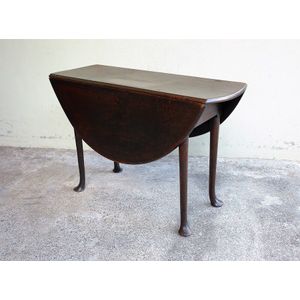George II Oak Drop Leaf Dining Table
You must be a subscriber, and be logged in to view price and dealer details.
Subscribe Now to view actual auction price for this item
When you subscribe, you have the option of setting the currency in which to display prices to $Au, $US, $NZ or Stg.
- Pad Foot - In furniture design, a pad foot refers to a type of
furniture foot that is shaped like a flattened ball or pad. It is a common
design element in traditional furniture styles, particularly in English and
American furniture from the 18th and 19th centuries. The pad foot is typically
wider than it is tall, with a broad, flat surface that rests directly on the
floor. It is often carved or turned with decorative details, such as fluting or
ridges, and can be made from a variety of materials, such as wood, metal, or
leather.
Pad feet are used to support the legs of various types of
furniture, such as chairs, tables, and cabinets. They are often used in
combination with other types of feet, such as bun feet or bracket feet, to
create a more complex and decorative furniture design. In terms of
functionality, pad feet provide stability and support to furniture pieces, and
can help distribute the weight of the piece evenly across the floor. In terms
of design, they add a classic and traditional look to furniture designs, and
are often used to create a sense of elegance and refinement. - George Ii - George II (1683 - 1760) was King of Great Britain and Ireland from 1727 until his death in 1760.
- Oak - Native to Europe and England, oak has been used for joinery, furniture and building since the beginning of the medieval civilisation. It is a pale yellow in colour when freshly cut and darkens with age to a mid brown colour.
Oak as a furniture timber was superceded by walnut in the 17th century, and in the 18th century by mahogany,
Semi-fossilised bog oak is black in colour, and is found in peat bogs where the trees have fallen and been preserved from decay by the bog. It is used for jewellery and small carved trinkets.
Pollard oak is taken from an oak that has been regularly pollarded, that is the upper branches have been removed at the top of the trunk, result that new branches would appear, and over time the top would become ball-like. . When harvested and sawn, the timber displays a continuous surface of knotty circles. The timber was scarce and expensive and was used in more expensive pieces of furniture in the Regency and Victorian periods.
This item has been included into following indexes:
Visually similar items

A George III red walnut wake table, Irish, 18th century. 72 cm high, 182 cm wide and 52 cm deep closed. Provenance: Private Collection, Melbourne

A George III mahogany drop-side gate-leg table, plain cabriole legs. 108 cm x 110 cm x 70 cm

George III oak oval gate leg dining table drawer to one end on squared chamfered tapering legs

A Georgian elm dough bin, of traditional country style, oblong shape with sloping ends and sides, supported on four simple tapering circular section splayed legs. 90 cm x 45 cm x 780
